Key Insights
- Stacks revenue (USD) increased 3,386% QoQ and 3,028% YoY to $637,000. Much of this revenue was driven by inscription protocol STX20.
- STX’s market cap increased 203% QoQ and 598% YoY to $2.0 billion. STX’s growth outpaced BTC and the overall crypto market.
- DeFi TVL (USD) increased 363% QoQ and 763% YoY to $61 million. ALEX firmly remained the leader in TVL, but Arkadiko and StackingDAO considerably increased their own TVL dominance in Q3 and Q4.
- Average daily miner revenue increased 1,015% YoY to $78,000. STX’s price increase and Stacks’ increased revenue made it significantly more profitable for Bitcoin miners to participate in Stacks’ consensus.
- The Nakamoto upgrade is expected in April 2024. This update will enable faster blocks, give transactions 100% Bitcoin finality, reduce MEV, and eliminate forking on the Stacks layer to set the stage for the upcoming sBTC release.
Primer
Stacks (STX) is a Bitcoin layer that enables smart contracts and decentralized applications to use Bitcoin as a secure base layer. Decentralized applications are executed on Stacks and settled on Bitcoin, leveraging the security and capital of Bitcoin while offering arbitrary programmability that is not possible on Bitcoin’s scriptable settlement layer.
Stacks has knowledge of the full Bitcoin state, thanks to its Proof-of-Transfer (PoX) consensus mechanism and Clarity programming language, enabling it to read from Bitcoin at any time. With PoX, miners commit BTC to eligible Stacks addresses that participate in consensus. This process of STX holders participating in consensus and earning BTC from miners is known as Stacking. PoX runs parallel to Bitcoin’s Proof-of-Work (PoW) consensus, hashing and settling Stacks transactions on the Bitcoin L1. Metadata from newly mined Stacks blocks is anchored to every Bitcoin block, allowing users to verify the canonical Stacks chain via Bitcoin blocks.
Stacks is a Bitcoin Layer-2 (L2) network, although the terminology is contested as networks colloquially referred to as Bitcoin L2s do not meet the criteria of L2s on other networks, such as Ethereum or Tezos. Stacks is the most ambitious programmable Bitcoin L2 (or sidechain) in terms of Bitcoin integration and modularity.
Website / X (Twitter) / Discord
Key Metrics
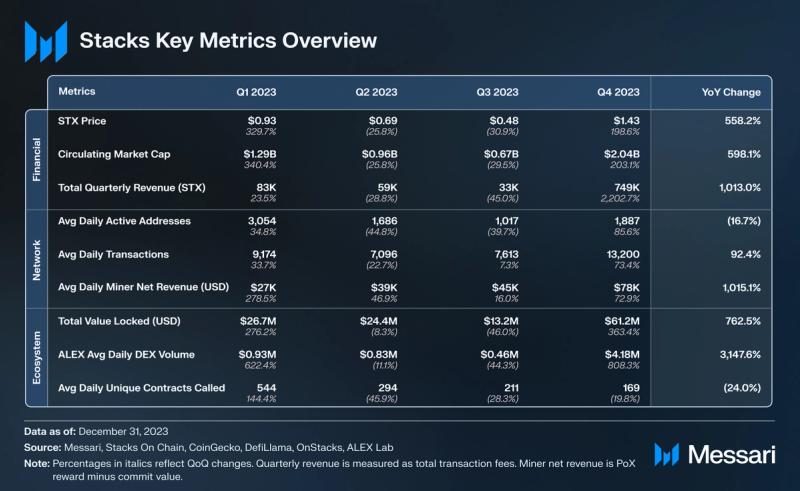
Financial Analysis

In Q4 2023, the total crypto market cap experienced a sharp increase, largely driven by anticipation surrounding spot BTC ETFs. STX’s circulating market cap increased 203% QoQ to $2.0 billion, outpacing the overall crypto market’s growth of 54%. This Q4 growth brought the market cap to increase 598% YoY. STX’s market cap rank among all crypto projects increased from 47th to 40th in Q4. STX is the native token on Stacks and is used primarily for transaction fees and Proof-of-Transfer (PoX) miner rewards (more on PoX in the Network Analysis section).

As a Bitcoin L2, Stacks is tightly coupled with Bitcoin not only in technical architecture but also in activity and price action. Still STX price outpaced BTC in 2023, specifically during Q4.
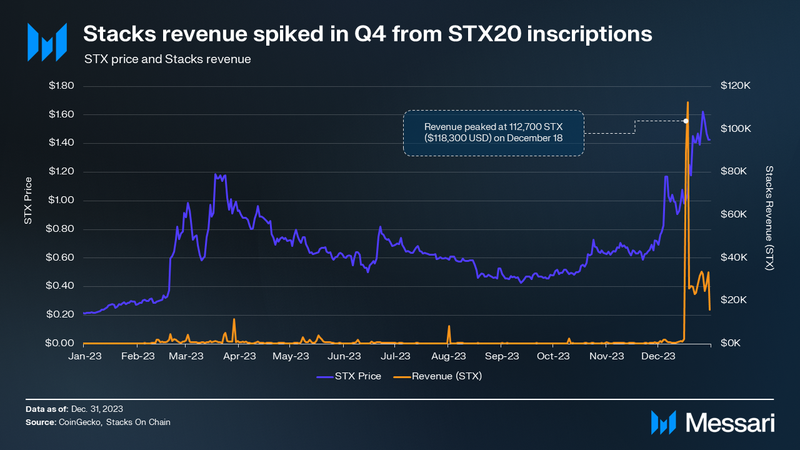
Revenue is measured as total transaction fees and is distributed to Miners through Stacks’ PoX mechanism (along with the coinbase reward, i.e., issuance). Q4’s quarterly revenue, denominated in STX, was 521,000, up 1,860% from Q3. Denominated in USD, Stacks revenue was $637,000 in Q4, up 3,386% QoQ and 3,028% YoY.
Network Analysis
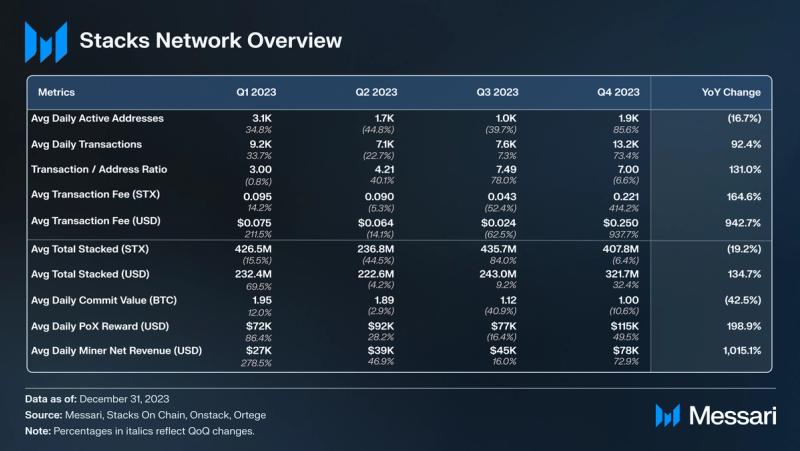
Average daily addresses and average daily transactions increased 65% and 52% QoQ, respectively. This activity was driven by new features on existing dapps, newly launched protocols (such as liquid stacking), and the introduction of Stacks’ first inscription protocol.
Average transaction fees (STX) increased 400% QoQ. These new programs created an urgency in which users sought to outbid each other to prioritize their transactions. The average transaction fee denominated in USD increased by an even greater amount, 894% QoQ. However, this difference was due to STX’s Q4 price increase. Even with the huge QoQ increase, the average transaction fee denominated in USD was still only $0.25.
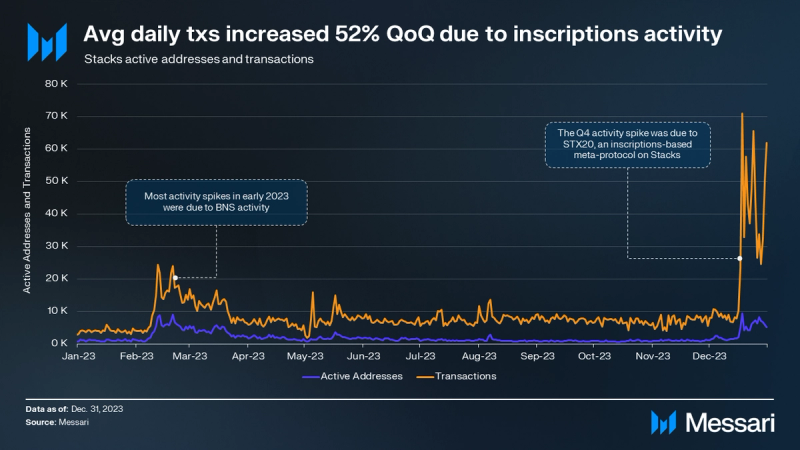
Transaction activity spiked in December following the launch of STX20. STX20 is an inscription protocol on Stacks, inspired by Bitcoin inscriptions (specifically BRC-20 Ordinals). Over 10,000 transactions were included in a single block in December due to STX20 activity, the largest Stacks block ever. Inscriptions are a transaction type popularized on Bitcoin in early 2023 which have popped up on almost every other large network since. They have even caused some outages due to the high activity volumes. Inscriptions are created by including arbitrary data in transactions, which makes them possible even on networks without native smart contract functionality.
Nakamoto Upgrade
The latest Stacks whitepaper (also known as the Nakamoto upgrade) describes a handful of protocol changes for
- Faster blocks
- Bitcoin finality
- Removing the chance of forks
- Reduced Bitcoin MEV
- The groundwork for sBTC, a trust-minimized BTC bridge to be enshrined into Stacks
Nakamoto reached several major milestones in Q4’23 — including the Neon testnet — and is expected to reach production in April 2024. Currently, Stacks has no enshrined cross-chain BTC bridge and is subject to Bitcoin block times, which average 10 minutes. After Nakamoto, the DeFi experience will improve considerably. Users will have faster block times, and the groundwork for sBTC, a trust-minimized bridged BTC, will be laid. Then, the DeFi experience on Stacks will be more comparable to other DeFi platforms, such as Ethereum or Cosmos, with the key difference of trust-minimized access to BTC liquidity.
The Nakamoto upgrade is enabled by two new technologies:
- Weighted Schnorr Threshold Signatures (WSTS) – Signatures are aggregated to make up one total signature. This allows them to be weighted: rather than requiring one signer for each reward slot, only one signer for each active signer/stacker would be necessary. The new process requires only ~150 signatures (the historical number of Stackers) instead of 4,000 (the number of total reward slots possible), making it fast enough for the Nakamoto upgrade’s faster block times.
- StackerDB – An overlay network for Stacks p2p network allows Stackers/nodes to store and share arbitrary data, such as smart contract data. The Nakamoto upgrade relies on an instance of this to coordinate signing between Stackers. The sBTC peg-out back to BTC also relies on this technology.
ClarityWASM is on the development roadmap after the Nakamoto upgrade. It is a WASM intermediary form for Clarity, which aims to enhance certain features of the Nakamoto upgrade. Its improved efficiency increases transaction bandwidth by an estimated 100x. As an interpreted language, Clarity doesn’t need to be compiled.
sBTC
sBTC, a trust-minimized form of bridged BTC, entered alpha testing in Q2’23 and a closed incentivized testnet in Q4’23. It is expected on mainnet in July 2024. Bitcoin Writes provides weekly sBTC updates.
The sBTC whitepaper was released in December 2022, detailing a trust-minimized two-way Bitcoin peg system. sBTC is positioned to be the first decentralized, non-custodial Bitcoin peg that allows smart contracts to write back to the Bitcoin blockchain. sBTC would allow BTC to move freely from Bitcoin to Stacks and allow users to deploy liquidity from Bitcoin directly to Stacks for DeFi, NFTs, and more. As with other bridged versions of BTC, moving off of the Bitcoin network is simpler than moving back onto it.
For the sBTC peg-in — moving from BTC on Bitcoin to sBTC on Stacks — users would send BTC to a threshold wallet where sBTC is minted by Stacks consensus and backed by BTC 1:1. Because Stacks already reads the Bitcoin mainchain, bridging BTC to sBTC requires no additional trust assumptions outside of Stacks and Bitcoin.
However, the peg-out – moving from sBTC on Stacks to BTC on Bitcoin – is not as straightforward and comes with additional trust assumptions. By utilizing the decentralized network of Stackers and delegating them to be threshold signers, Stackers (STX stakers) inherit the responsibility to fulfill sBTC peg-out requests. Since Stackers already have an economic incentive, peg fees become unnecessary. There is an economic trust assumption on the peg-out, unlike the cryptographic trust assumption on the initial peg. As a result, the peg is just trust-minimized and not entirely trustless.
Unlike other synthetic BTC variants, like wBTC (wrapped BTC) and RBTC (Rootstock BTC), sBTC doesn’t rely on federations or centralized custodians. Instead, sBTC relies on an open network in which anyone can help maintain the peg. The open membership of users is maintained by incentivizing users to behave rationally as the most profitable course of action. sBTC is somewhat similar in design to tBTC (Keep Network BTC), a permissionless Ethereum-wrapped BTC. However, tBTC is settled on Ethereum, and it utilizes an additional set of signers for peg requests and overcollateralization ratios.
Bitcoin MEV
Stacks experienced a miner extractable value (MEV) issue related to Bitcoin miners in 2023. The upcoming Nakamoto upgrade aims to reduce Bitcoin MEV by raising the cost of MEV behavior. By nature, all (shared) security models carry some sort of risk. Stacks’ PoX is similar to merge-mining in that a miner on the “parent chain” (i.e., Bitcoin) could carry out an attack with no risk of financial loss.
Bitcoin miners submit block commits as part of Stacks consensus, essentially bidding on the chance to win the PoX rewards (i.e., the STX coinbase reward). The value of the block commit submitted by a miner is directly proportional to a miner’s chance of winning the PoX rewards. With only one block commit, a miner would win the PoX rewards by default.
F2Pool, a major Bitcoin mining pool, realized this dynamic and began to censor all other block commits whenever it produced a Bitcoin block. With the competition for the PoX rewards eliminated by censoring the block commits from other miners, the block-producing miner could submit a minimal amount of funds in its block commit and still win. This is the miner extractable value (MEV) that F2Pool has been executing through 2023. While this extraction of value was technically always possible, it was only recently exploited as Stacks grew larger and became profitable.
The community has explored several solutions, including ideas such as:
- Incentivizing collaborative mining by speeding up block production and eliminating incentives based on coinbase rewards.
- Transaction smoothing across multiple Bitcoin blocks.
- Reward weighting.
The leading solution to be included in the Nakamoto upgrade is Assumed Total Commit with Carryover (ATC-C). This is a new weight function for the sortition algorithm. Even if a miner puts in a significant amount of Bitcoin to mine a Stacks block, they would have a 0% chance to win the sortition had they not been mining at least 50% of the time over the last several blocks. In other words, this update doesn’t guarantee PoX rewards to miners who were the only ones to submit a block commit. This setup reduces the arbitrage possible on block commit “bids” versus PoX rewards, and it makes miners contribute more to Stacks to be eligible to receive the rewards.
Stacking

The Stacks PoX consensus mechanism, Stacking, involves both Bitcoin miners and Stacks stakers. Bitcoin miners include commit values, which entails sending BTC to STX stakers. The block reward (i.e., coinbase reward) from Stacks blocks, as well as Stacks transaction fees, all get sent to the winning Bitcoin miner in the form of STX.
Stacking on Stacks, similar to mining on Bitcoin, is largely dominated by pools. Because of this, the number of participants across decentralized and custodial stacking pools (and as of Q4 2023, liquid stacking protocols as well) is considerably lower when counted as unique stackers. In Q4 2023, there were 58 unique stackers, but several pools had 10-20x as many participants. It is impossible to know how many participants are in the custodial pools, as the data isn’t directly onchain. However, the number of unique miners can be determined by counting the number of miners to include commits in the op_return field of Bitcoin transactions. Again, this unique miner metric is dominated by pools.
The average daily commit value sent from Bitcoin miners to STX stakers was 1.0 BTC in Q4, or $37,000 denominated in USD. The average daily PoX reward (made up of both the block reward and transaction fees from Stacks) was $115,000 in Q4. This made the average miner revenue $78,000 over Q4. This value was up 73% QoQ and 1,015% YoY, largely due to the appreciation in STX’s price during 2023. STX’s price increase and the increase in fees made stacking significantly more profitable for Bitcoin miners. In turn, it should economically incentivize more miners to participate in securing Stacks through stacking, which would then reduce the average daily revenue until it reached an equilibrium.
Stacking rewards were impacted by a bug in the stacks-increase function in Q2’23. The community and developers reached a consensus on resetting the PoX state and implementing a fork to revert the network to proof-of-burn temporarily. PoX Stacking was disabled for Cycles 58 and 59, or approximately one-third of Q2. The Stacks 2.4 hard fork re-enabled Stacking on May 26 prior to Cycle 60, ~5 weeks after the bug was identified.
Ecosystem Analysis
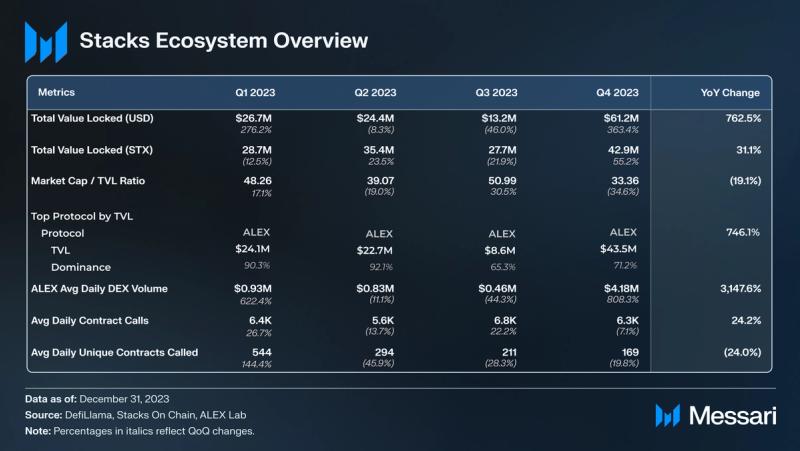
Stacks’ ecosystem saw growth from both existing and new protocols in 2023, with many more in development. The Stacks ecosystem includes:
- ALEX – a multi-headed protocol including an AMM, BRC-20 DEX, launchpad, bridge, and more
- Arkadiko – a stablecoin issuer and DEX
- Gamma – an NFT marketplace
- StackingDAO – a liquid staking protocol
- STX20 – an inscription protocol
- Leather and Xverse – browser wallets
- UWU – a stablecoin and loan protocol
- Bitflow – a DEX
- Zest – a lending protocol
- Hermetica – a platform for Bitcoin yield products
- Velar – a perpetuals DEX
Some of these protocols, which have either just launched or are nearing mainnet, are running points programs in an effort to onboard more users. StackingDAO and Bitflow have programs already running, with rumors of programs from Hermetica, Zest, and Velar. A broader view of the ecosystem can be found here.
DeFi
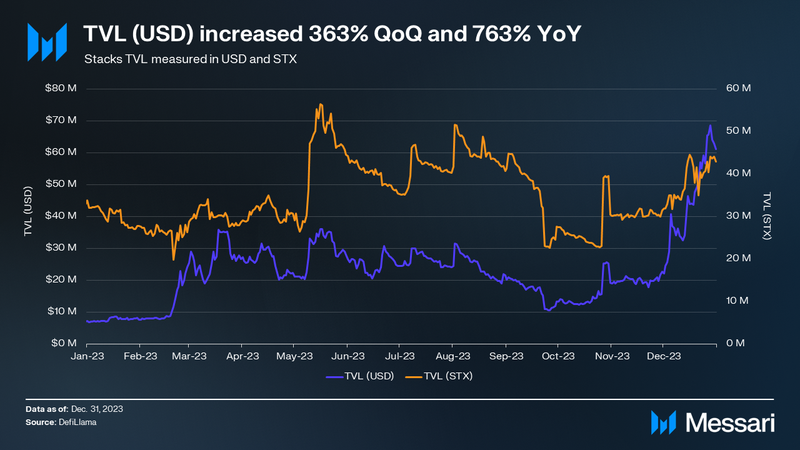
December 28, TVL (USD) reached an all-time high of $69 million. TVL (USD) increased 363% QoQ and 763% YoY. There were many contributing factors, including:
- The launch of StackingDAO, the first liquid staking protocol on Stacks.
- The launch of ALEX B20, the first-ever decentralized order book for BRC-20s. BRC-20 is a fungible token standard on Bitcoin created by Domo, who is now on ALEX’s advisory board.
- The Launchpad, a platform made to facilitate the launch of BRC-20s, had its first release in Ordmint.
- The Stacks Ethereum and Stacks BNB bridges launched.
- The launch of sUSDT, bridged USDT.
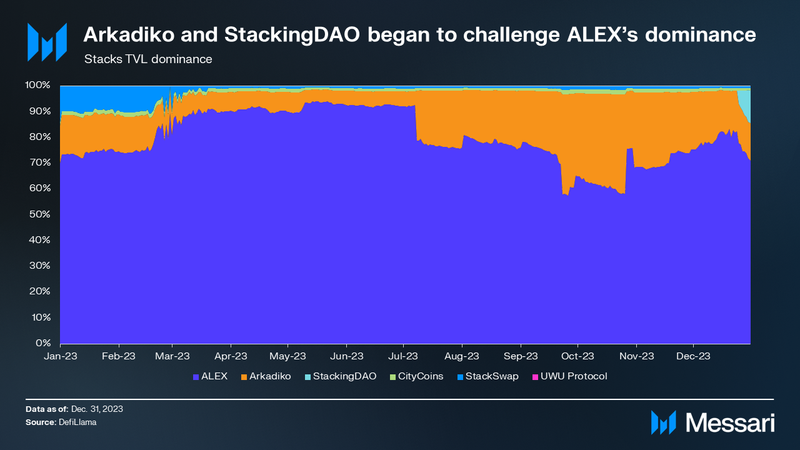
DeFi Diversity denotes the number of protocols comprising the top 90% of DeFi TVL. A wider spread of TVL across protocols can mitigate potential systemic risks from negative events. Stacks concluded Q4 with a DeFi Diversity score of 3. For reference, Ethereum and Solana’s DeFi Diversity scores were 21 and 19, respectively. ALEX remained the most dominant protocol by TVL throughout 2023, although the growth of other protocols (such as Arkadiko and StackingDAO) began to reduce ALEX’s dominance in Q3 and Q4.

ALEX is a multi-headed DeFi protocol, focused on trading and lending/borrowing cryptoassets with Bitcoin as the settlement layer. The automated market-making (AMM) protocol is at the core of ALEX’s ecosystem, providing liquidity for its Launchpad and Orderbook. ALEX’s DEX volume increased 808% QoQ and 3,148% YoY. Volume peaked at $15.0 million on November 17 and averaged $4.2 million per day throughout Q4.
The immediate focus for ALEX is to build the most user-friendly, scalable BRC-20 trading DEX. Other services include Trading Pool, Lend/Borrow, and Launchpad, with more to come in its new roadmap.
Growth and Development
According to Electric Capital’s 2023 Developer Report, 40% of Bitcoin ecosystem developers are working on L2 and scaling solutions. Over 300 developers were building on Stacks in 2023, with 12% QoQ growth in Q4.
Notable ecosystem developments include:
- The Decentralized Grants Pilot Program was launched.
- Hackathons by Hiro, Stacks Foundation, EasyA, and others saw over 2,500 devs completing challenges in Q4, and 250 hackers working on sBTC testnet / Stacks.
- Hiro Hacks introduced coding challenges and BTC prizes for ecosystem developers.
- Pyth price feeds launched.
- Figment announced support for the Nakamoto upgrade, which will make stacking accessible for its institutional clients.
- Xverse added Ledger support for its wallet.
- The Decentralized Grants Program funded ecosystem builders.
- StackingDAO launched as the first liquid staking protocol.
- Hermetica integrated sBTC in its testnet platform.
- The Bitflow DEX testnet launched.
- XLinkDAO formed, as the ALEX Bridge became XLink, an independent entity.
Various entities released reports featuring Stacks in late 2023:
- Spartan Group Bitcoin L2 Report
- DeFi is Bitcoin’s missing ingredient
- Report: The Past, Present and Future of Bitcoin Ecosystem – ABCDE Labs
- Alliance Dao: In Bitcoin land, L2s are coming
- Binance Research Report: Are We Entering A Bull Market?
- Bitcoin thesis including Stacks as leading L2
- North Rock Digital releases thesis on Stacks
Bitcoin Analysis
As a Bitcoin L2, Stacks tends to follow the larger trends around the greater Bitcoin ecosystem. Bitcoin’s trends in 2023 were
- Meta-protocols, such as Ordinals, introduced NFTs and “fungible” tokens to Bitcoin on the base layer via inscriptions.
- Onchain programmability. BitVM pushed Bitcoin’s current computation boundaries, all without a soft fork. So far, builders have detailed or built an 8-bit CPU, 2-way peg sidechains, atomic swaps with Lightning, and more using BitVM. Several BIPs and opcodes to add more onchain programmability to Bitcoin received attention from the community as users discussed their potential implementations; these included OP_CAT, OP_CTV, and Drivechains.
- TradFi interest, through BTC spot ETFs. These ETFs were approved in January 2024 and marked a significant milestone for the legitimacy of BTC in the eyes of both regulators and TradFi.
All of these narratives had, and will continue to have, an impact on Stacks.
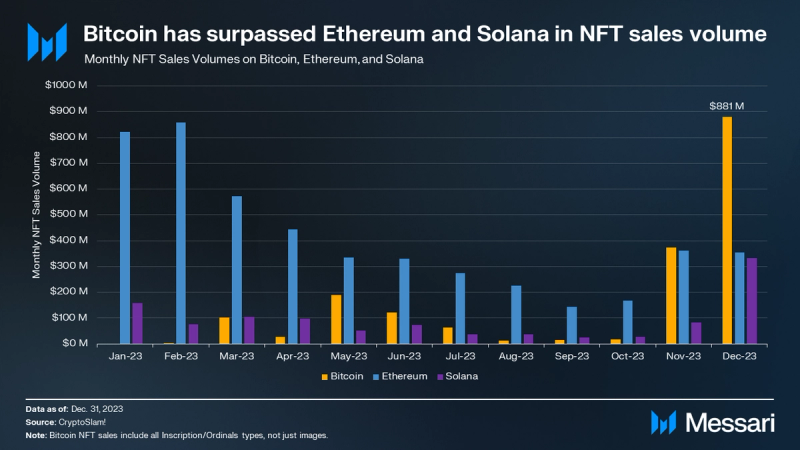
The above chart includes both traditional NFTs (i.e., images) and BRC-20s (which are semi-fungible tokens like ERC-1155 NFTs, but are treated by many users like fungible tokens). As far as DEX volumes go, Bitcoin’s inscription sales volume would be ranked 10th among all chains as of the end of Q4. Ordinals proved that the Bitcoin ecosystem is interested in NFTs and new functionalities. Bitcoin can support some functionalities, but Stacks can provide much more as a Turing-complete network. Stacks was used to build DEXs, explorers, and other services for Ordinals that Bitcoin could not support.
Ordinals drove activity to Stacks not only through the desire for full programmability but also due to fees. Bitcoin’s average transaction fee increased 714% YoY to $9.90 in Q4’23, pricing out many users and pushing them to L2s like Stacks. The mania around Ordinals is what caused the fee spikes and network congestion.
New breakthroughs in onchain programmability brought more attention to Stacks. Users and builders were excited by the ways these new technologies could benefit Bitcoin and Bitcoin L2s. Safer bridging models, L2 transaction validation, and native proof generation may become possible through technologies like BitVM. Additionally, all Bitcoin projects, including Stacks, will benefit from the influx of developers building Bitcoin L2s..
As seen in the past, the BTC halving in April 2024 (which coincides with the STX halving) is expected to bring more attention to Bitcoin and by extension Stacks. With BTC accessible to trillions of AUM through TradFi ETFs, an imminent halving, and a renaissance of programmability, Bitcoin’s 2024 narratives will continue to drive Stacks’ narrative as the leading Bitcoin L2.
L2 Landscape
Bitcoin has seen a vibrant L2 ecosystem emerge this year, which will compete with Stacks upon their launches. Among existing programmable L2s/sidechains (e.g., Liquid, Rootstock, and Internet Computer), Stacks is the most ambitious in terms of Bitcoin modularity and integration. Compared to client-side validated L2s (e.g., Lightning and RGB), Stacks uniquely offers full programmability. Stacks does not have an enshrined cross-chain BTC, but that will soon change with sBTC.
Most new teams are building fully programmable Bitcoin L2s. Specifically, many teams are building validity or sovereign rollups (or infrastructure for them(, such Chainway, ZeroSync, Rollkit, Kasar, Botanix, Bison, ZeroSync, BOB, Mintlayer, Rollux, Sovryn/BitcoinOS, BSquared, and more. While there is much debate over the definition of a Bitcoin L2, Stacks and almost all of these other projects are marketed as such.
Closing Summary
Stacks activity surged in Q4. Stacks revenue (USD) increased 3,386% QoQ, driven by both STX’s 199% QoQ increase and the activity spikes from the STX20 protocol. Other new protocols drove activity, such as liquid-staking service StackingDAO. There will be more protocols launched in 2024, including Bitflow, Zest, Velar, and others.
Stacks has emerged as the leading Bitcoin layer, in a time when many protocols have just begun to build on Bitcoin. It may further solidify this role in 2024 as key network upgrades hit mainnet, namely the Nakamoto upgrade (expected in April) and sBTC (expected in July). The Nakamoto upgrade will enable faster blocks, give transactions 100% Bitcoin finality, reduce MEV, and eliminate forking on the Stacks layer to set the stage for the upcoming sBTC release.

















